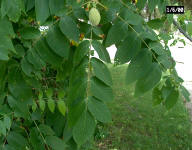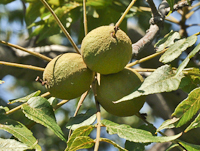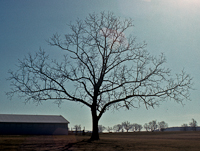|
 The
black walnut tree (Juglans nigra) produces a natural phytotoxin called juglone in its roots, leaves, fruit, hulls,
and bark. This substance is not secreted into the soil but
rather, remains in the plant tissues and is most persistent in
the roots. Other nut trees such as hickories and other species
of walnut also produce the toxin but it is not as potent as it
is in black walnut. The
black walnut tree (Juglans nigra) produces a natural phytotoxin called juglone in its roots, leaves, fruit, hulls,
and bark. This substance is not secreted into the soil but
rather, remains in the plant tissues and is most persistent in
the roots. Other nut trees such as hickories and other species
of walnut also produce the toxin but it is not as potent as it
is in black walnut.
The roots of
plants susceptible to this toxin must come into contact with
walnut roots or other tissues for symptoms to develop. Some
plants such as tomatoes are extremely sensitive to juglone
while other plants appear not to be effected at all.
On average, the toxic zone extends over the
entire root zone of the tree which may extend 60 feet or more
from a mature specimen. Near established groves of walnut
trees, the toxicity may occur for a distance of over 80 feet.
 The toxin will persist in the soil for up to
3 years after a tree is removed. Total removal of the soil in
the root zone is a drastic (and expensive) alternative in
extreme cases. The toxin will persist in the soil for up to
3 years after a tree is removed. Total removal of the soil in
the root zone is a drastic (and expensive) alternative in
extreme cases.
Controlling the spread of the tree roots
with solid barriers is another option, but with highly
sensitive plants, other walnut tissues (i.e. leaves, bark,
etc.) may still prove toxic.
Symptoms of toxicity range from stunted
growth, partial or total wilting of the plant and, in severe
cases, death. Affected plants often appear to be growing well,
then suddenly wilt or die. Plantings in the root zone of young
walnut trees will experience toxicity as the tree matures and
the root system expands.
 Walnut
trees are relatively fast growing, produce edible nuts, and
make a formidable statement in a landscape. Considering the
value of any mature tree, it is better to consider using
compatible plants in the landscape rather than removing large,
existing walnut trees. Planting new walnut trees should be
avoided on small lots or near houses. Walnut
trees are relatively fast growing, produce edible nuts, and
make a formidable statement in a landscape. Considering the
value of any mature tree, it is better to consider using
compatible plants in the landscape rather than removing large,
existing walnut trees. Planting new walnut trees should be
avoided on small lots or near houses.
Other species in the walnut family
containing juglone in lower concentrations (listed in order of
decreasing concentration of juglone) include: English Walnut [Juglans
regia], Butternut [Juglans cineraria], Shagbark
Hickory [Carya ovata], and Pecan [Carya
illinoinensis].
 Refer to a lists of plants that have been observed as
being either susceptible or resistant to the effects of juglone. Although
these lists contain the names of many plants, they are
certainly not all inclusive. Many plants have either not been
observed or reported as to their response to contact with the
roots of walnut trees. Refer to a lists of plants that have been observed as
being either susceptible or resistant to the effects of juglone. Although
these lists contain the names of many plants, they are
certainly not all inclusive. Many plants have either not been
observed or reported as to their response to contact with the
roots of walnut trees. |



